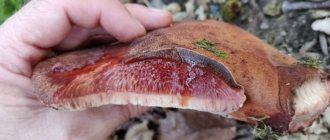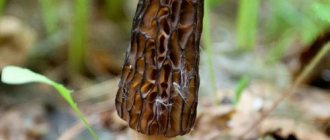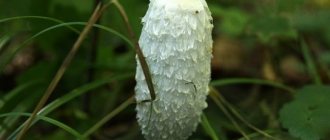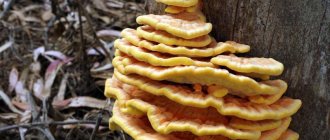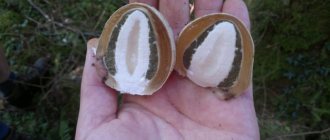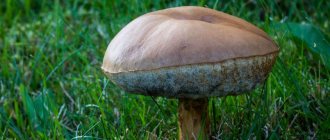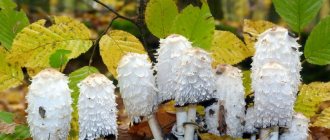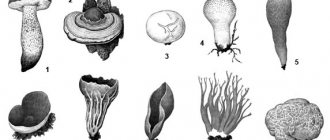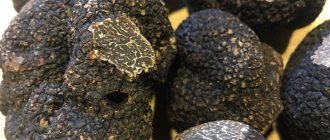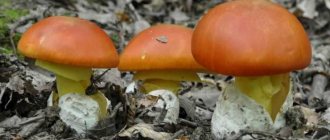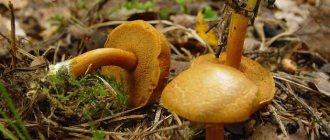It has been used for centuries in traditional Chinese medicine. Today, it is still renowned for its medicinal properties, including anti-inflammatory and antioxidant effects.
This article discusses the benefits and harms of Tremella fucus, the uses and methods of preparing and consuming this mushroom.
What is this ice mushroom and what does it look like?
The ice mushroom is known by many names - snow, silver, jellyfish mushroom, white or spindle-shaped trembler, silver or snow ear, tremella fucus.
A photo of a snow mushroom shows that in appearance it resembles a kind of ice flower, translucent and very beautiful. The photo of the ice mushroom shows that its fruiting body is elastic and elastic, similar to gelatin, but at the same time quite hard. Tremella is whitish and translucent in color, can reach up to 4 cm in height and up to 8 cm in diameter. Its surface is shiny and smooth.
The fucus tremella looks like an ice flower
The snow mushroom does not have a clearly defined stalk; the fruiting body grows directly from the tree trunk. The pulp of the fucus tremella is the same whitish-transparent as the entire fruit body, and does not have a strong smell or taste.
Structure and features of the species
The description of the fusiform tremors is not at all the same as that characteristic of other types of mushrooms. The fruit does not have a stem or cap, and there is no hymenophore, so it cannot be said that it belongs to lamellar or tubular fruits.
The fruiting body of the mushroom can be described as gelatinous. It looks like jelly, jelly or jellyfish. However, it feels quite dense to the touch. It is formed by peculiar graceful petals. In some individual specimens, the fruiting body resembles a chrysanthemum bud in appearance.
As for color, Tremella fuciformis has a fairly wide range. In some cases, the mushroom is almost completely transparent, but most often it is whitish or yellowish. The fruit reaches 7-8 cm in diameter and grows up to 4 cm in height. The surface of the ice mushroom is shiny and smooth to the touch.
Spore powder is white. The spores are smooth and ovoid in shape.
boletus
There is probably no mushroom picker who doesn’t know this delicious mushroom with a telling name.
The common boletus (Leccinum scabrum) has a neat semicircular cap with a diameter of 5–15 cm with smooth skin of a gray-brown or brownish hue. The second distinctive feature is a high (up to 15 cm) leg, covered with black scales that from a distance resemble specks. If you break the mushroom, you will see white or slightly pinkish flesh. Young boletus mushrooms are especially good. As it matures, the pulp loosens and becomes less tasty.
Where does it grow
In mixed and deciduous forests, the main thing is that there are birch trees nearby. You need to look for the mushroom under trees and on well-lit forest edges.
What can be confused with
Dangerous counterparts of Leccinum scabrum include the same inedible gall fungus. In order not to confuse them, take a close look at the leg of the gall mushroom - it is covered not with scales, but with a brown mesh. Its tubular layer is pinkish. On a break, the gall fungus turns red, but the boletus mushroom does not have this.
How and where does ice mushroom grow?
Fucus tremella prefers a warm, preferably tropical climate. Therefore, on the territory of Russia it can only be found in Primorye and in the Sochi region, where average annual temperatures remain quite high.
Since the snow mushroom is a parasitic organism, it settles on the trunks of fallen trees and draws juices and minerals from them. In Russia you can see it mainly on oak trees. Tremella appears in mid-summer and bears fruit until mid-September; it can grow either singly or in small groups.
Silver ear grows on deciduous tree trunks
Is the mushroom edible or not?
Despite its unusual appearance and consistency, the snow mushroom is completely suitable for food. It is not recommended to eat it raw, but after processing it can be added to a variety of dishes.
How to cook ice mushrooms
Snow shaker is used very widely in cooking. It is not only boiled and fried, but also pickled, salted for the winter and dried. Tremella can be added to soups and main courses; it can serve as a good side dish for potatoes, pasta and cereals.
Before any preparation, the silver ear must be processed and prepared. There is no need to clean it, since it does not have ordinary legs and a cap. It is enough to simply cut off the small roots through which the tremella receives nutrients and shake off the remaining forest debris.
Before cooking, fresh snow tremors need to be boiled, or rather, steamed for 10 minutes in hot water. Steaming not only eliminates possible harmful substances in the composition, but also increases the volume - the silver ear swells by about 3 times.
Fucus tremors are actively used in cooking
Distribution and fruiting period
Fucus tremella is found in deciduous and mixed forests, growing on branches of deciduous trees and fallen trunks, on rotten wood (favorite types of wood are Indian mango and oak). Tends to lead a parasitic lifestyle on other mushrooms. The fruiting period is August-October. Tremella is found both in groups and alone.
In Russia, tremella grows only in Primorye and loves wet places. Also common in Australia, Central America, Asian countries and the Pacific Islands.
Where do they grow, in what forests and how to collect tremella
Tremella is considered a parasitic fungus. The fruit can be found growing on Archer's annulogipoxylon. This is a saprotrophic fungus, the distribution area of which is not too wide.
Tremella can also be found on fallen wood, broken branches and dead large-deciduous trees. This mushroom can be called exotic, since of all existing trees it most often chooses Indian mango. Grows singly or in small groups.
Tremella fuciformes was discovered in Russia in Primorye. The place where it grew was an oak grove.
The mushroom loves tropical and subtropical climates. It is actively collected in Asian countries, Central America, New Zealand, Australia and the Pacific Islands.
In Russia, to use Tremella fuciformes for medicinal purposes, its artificial cultivation is practiced. This is a very complex and time-consuming process. Exactly the same as, in fact, picking fruits.
To harvest coral mushrooms, you need to use a thin knife. They need to carefully trim the fruit at the base, and then very carefully remove it from the mycelium. It is better to lay tremella on a flat surface. Under no circumstances use a bag or bucket for this, as this can damage the structure of the delicate fruiting body. After harvesting, it is recommended to immediately process the mushrooms.
Recommendations for selection
By following some basic tips, you can achieve a good harvest very quickly. The main thing is to strictly follow the necessary instructions regarding the selection of key points.
View
Among the huge variety of mushrooms, you need to decide which ones to plant. As the experience of many gardeners shows, the most popular are:
- White (boletus).
- Oyster mushrooms.
- Milk mushrooms.
- Butter.
- Honey mushrooms.
- Boletus mushrooms.
- Boletuses (redheads).
- Saffron milk caps.
- Champignon.
It is these species that have shown themselves to be the most successful options for adaptation for cultivation in a summer cottage. Find out more: How to grow honey mushrooms in a summer cottage A real giant - a raincoat round like a ball - is often found in gardens or vegetable gardens in the regions of our country. Having discovered it, it is worth observing this place. As a rule, other instances will appear later.
Place
It is necessary to study in advance the characteristics of the species and favorable conditions for its growth. It is believed that for reproduction and good growth it is necessary to create areas as similar as possible to forest conditions.
The trees (stumps, logs) under which the sowing will be carried out are also important. It is known that the qualitative development and growth of the mycelium occurs with its constant interaction with the roots. For example, boletus mushrooms love spruce, porcini mushrooms love soil with pine needles, and grow under pine trees. Birch logs are suitable for oyster mushrooms, and apple orchards are suitable for morels. Aspen boletuses, as the name suggests, are associated with aspen, but are also found next to birch trees.
Forest species cannot be planted under fruit trees (apple trees, pears). It is better to choose those species in which they grow in the forest.
A mandatory factor is fertile and moist soil with shading near the building or trunks, the distance to which is at least 0.5 - 1.0 m.
It is also worth taking into account that the mushroom bed must be located at a certain distance from the main garden with vegetables and berries.
Substrate
The soil on which it is planned to grow mushrooms is one of the important factors that ensures their nutrition. Simply sowing mycelium in the garden like vegetable crops and waiting for the harvest is not suitable. The following species are considered ideal substrates:
- forest litter;
- various plant wastes;
- humus soils;
- wood;
- sawdust;
- needles;
- fallen leaves.
Later, during sowing, it is recommended to introduce special growth activator preparations, which must be used only in accordance with the attached instructions.
Terrain, climate
Weather conditions are less important than for various plants, however, agronomists recommend choosing species that are characteristic of growing in forests, steppes or meadows of each individual region.
Deadlines
The best period for planting is considered to be the beginning of spring, at which time the snow has already melted and the earth is warming up. In the heat, the habituation and adaptation of the mycelium will be worse, and spring rains and abundant moisture will help it quickly take root in a new place.
In order to grow wild mushrooms in the country, you need to be guided by the natural timing of their ripening. For example, when independently preparing planting material for species such as boletus and boletus, you need to focus on June or September. These dates depend annually on what the summer was like.
Sowing should be done on a cool, cloudy day in the morning or in the evening.
Some gardeners say that you can sow mycelium all season from spring to autumn (May - September), depending on weather conditions. If the summer turned out to be cool and rainy, you can safely begin planning site preparation and planting.
Botanical characteristics
In appearance, the mushroom fruiting body is similar to algae or coral growth, which has numerous branches. It grows up to 7.5 centimeters in diameter. There is no clearly defined division into stem and cap.
In conditions of high humidity, the surface becomes slippery and jelly-like. The structure of the fruiting body is quite comparable to a transparent white gelatinous substance.
The mushroom has several names. The Chinese called it the silver ear, the Japanese called it the white tree ear. Scientific name: Tremella fucus.
Leads a predominantly parasitic lifestyle, settling on other representatives of the fungal kingdom. Forms and develops a fruiting body after invading foreign mycelium. However, it is still not clear whether this is parasitism or some other form of mutual coexistence of two organisms.
Black rice porridge with silver ears
black rice, silver ears, dates, candy cane, gingko biloba, walnut kernels and peeled peanuts.
How to cook?
Soak black rice overnight in 5-7 times the volume of water. Pre-soak coral mushrooms for an hour, wash and remove hard stems, chop. Bring the rice to a boil and add porcini mushrooms, dates, candy cane, gingko biloba, walnut kernels and peeled peanuts. Cook the porridge for about an hour over low heat, stirring so that the mushrooms do not stick to the pan. The dish has high nutritional value.
Recipe:
Chemical composition and calorie content
The calorie content of ice mushroom is low: about 86 kcal per 100 g (for cultivated mushrooms).
Chemical composition:
- 1.6 g protein;
- 4.3 g fat;
- 2.8 g carbohydrates;
- 91.3 g water.
There is no dietary fiber.
The vitamin and mineral composition is represented by a huge number of amino acids, organic acids and sugars, but two main elements can still be clearly distinguished:
- calcium – 643 mg;
- iron – 30.4 mg.
The calorie content of Tremella fuciformes grown in the wild is on average 56 kcal per 100 g.
The calorie content of pickled ice mushroom is already 376 kcal per 100 g.
Primary processing and preparation
Tremella fuciformis is very popular and is often used in Chinese dishes. It is often the basis for sweet culinary masterpieces. Tremella itself is tasteless, it only crunches very appetizingly, but, thanks to its special gelatin-like structure, it absorbs various liquids well.
Over time, tremella began to be used for making syrups, drinks, ice cream, soups and other dishes. Now the mushroom is considered an excellent snack. In Russia it is often used as “Korean salad”.
Drozhalka is a fairly nutritious mushroom that does not require long-term heat treatment (it is boiled for only 5 minutes, and the fruiting bodies increase significantly in size).
Medicinal properties
Coral mushrooms also have healing properties. Their pulp contains a large amount of vitamin D, B, polysaccharides, as well as many other useful substances. Polysaccharides protect the digestive system by forming a so-called mucoid film on the gastric mucosa. They are also an excellent environment for the growth of probiotic microorganisms, prevent the absorption of fats, help overcome excess weight, and replenish lost strength.
Tremella pulp contains dietary fiber, proteins, fats, carbohydrates, fiber, 18 amino acids, minerals, glycogens, and trace elements. This is a very valuable food product.
Tremella is able to cope with inflammation and allergies, fights tumors (the fungus is the basis for the production of the drug tremellastin) and exposure to radiation, and reduces cholesterol levels.
Tremella has been used in cosmetology for many years - it copes well with wrinkles. It is especially appreciated by Chinese and Japanese women. An anti-aging effect is also exerted by an increase in the level of a special enzyme in the liver, brain, and skin - superoxide dismutase.
The mushroom has no contraindications for use, but pregnant women should use preparations based on it with caution, and it is better to completely abandon them while carrying a baby. Also, children and nursing mothers are not advised to eat tremors. It should not be used if you are taking anticoagulants.
Fucus tremella has been cultivated in China for more than 100 years, and about 50 in Korea. In Thailand, the mushroom is sold dried, while the newly saturated mushrooms are completely indistinguishable from freshly picked ones. Now tremella is available to everyone, including being sold in Russian stores. So the desire to try it can quickly come true.
Tree Ears (Cloud Ears, Tree Mushrooms, Muer, Head Hunu)
In the photo above, the dark-colored mushrooms in the center are tree abalone mushrooms. These mushrooms have almost no taste, but leave a feeling of something smooth on the tongue and at the same time have a pleasant crunch.
Tree Ears (Cloud Ears, Tree Mushrooms, Muer, Head Hunu)
Wood abalones are used to prepare fried and stewed dishes, as well as soups. Muer mushrooms are a storehouse of vitamins and microelements; they contain a lot of iron. It is valuable that mushrooms are subjected to heat treatment for a very short time.
tree ears
These mushrooms have spread throughout the world from China. They are usually sold dried, but Thai stores and markets almost always have fresh ones. A classic Thai-Chinese recipe using them is chicken stir-fry with ginger and wood mushrooms.
stir fry with meat, abalone and vegetables
The benefits and harms of snow mushrooms
The unusual tremella fucus has numerous beneficial properties. In particular, she:
- increases immune resistance and accelerates regeneration processes in the body;
- improves blood circulation and prevents the development of varicose veins and thrombophlebitis;
- reduces the level of glucose and bad cholesterol in the blood, strengthens blood vessels and improves heart function;
- has a beneficial effect on the respiratory system;
- regulates digestion and metabolic processes;
- accelerates peristalsis and stimulates bile secretion.
Tremella also has contraindications. These include:
- pregnancy and lactation - any mushroom pulp is dangerous for pregnant women and nursing mothers;
- children's age - you can offer snow mushroom to a child only after 7 years;
- individual intolerance.
Also, you should not use white tremors at the same time as taking blood thinning medications.
Silver ear has numerous valuable properties
Immunity
The mushroom is able to remove toxins from the body
The mushroom mucous structure contains polysaccharides that are involved in the process of production of protein compounds by the human body - interferon and interleukin-2 from the group of cytokines. These substances are indispensable for sustainable immunity and stimulate the formation of macrophages absorbing microbes. In addition, the fungus is characterized by the ability to activate the activity of “natural killer” cells and increase the effectiveness of antibodies.
Thus, the main task of interferons is to induce and activate cellular proteins that block the development of the virus. Interleukins are part of the immune system and are mobilized in response to pathological influences on the body.
How is it useful for oncology?
The valuable properties of tremella fucus are used in the treatment of cancer. It has been proven that white trembling increases the body's endurance and makes it more resistant to radiation, removes toxic substances from tissues and accelerates recovery processes. Snow mushroom is recommended for use after a course of chemotherapy; it helps the body better cope with the side effects of treatment.
The use of silver mushrooms in cosmetology
The benefits and harms of ice mushroom also affect the cosmetology field. Mushroom pulp contains many polysaccharides with chemical characteristics similar to hyaluronic acid.
Store-bought and home remedies containing tremella fucus extract have a moisturizing and rejuvenating effect on the skin. Masks and lotions containing tremella help clear the face of acne and blackheads, increase the firmness and elasticity of the epidermis, and even out the complexion.
Tremella is also used to create hair masks. The beneficial substances contained in the snow mushroom nourish the scalp and prevent the appearance of dandruff.
Excerpt characterizing Tremella fuciformis
“Such a strange antipathy,” thought Pierre, “but before I even really liked him.” In the eyes of the world, Pierre was a great gentleman, a somewhat blind and funny husband of a famous wife, a smart eccentric who did nothing, but did not harm anyone, a nice and kind fellow. During all this time, a complex and difficult work of internal development took place in Pierre’s soul, which revealed a lot to him and led him to many spiritual doubts and joys. He continued his diary, and this is what he wrote in it during this time: “November 24th. “I got up at eight o’clock, read the Holy Scriptures, then went to office (Pierre, on the advice of a benefactor, entered the service of one of the committees), returned to dinner, dined alone (the Countess has many guests, unpleasant to me), ate and drank in moderation and After lunch I copied plays for my brothers. In the evening I went to the countess and told a funny story about B., and only then did I remember that I shouldn’t have done this when everyone was already laughing loudly. “I go to bed with a happy and calm spirit. Great Lord, help me to walk in Your paths, 1) to overcome some of the anger - with quietness, slowness, 2) lust - with abstinence and aversion, 3) to move away from vanity, but not to separate myself from a) public affairs, b) from family concerns , c) from friendly relations and d) economic pursuits.” “November 27th. “I got up late and woke up and lay on my bed for a long time, indulging in laziness. My God! help me and strengthen me, that I may walk in Your ways. I read Holy Scripture, but without the proper feeling. Brother Urusov came and talked about the vanities of the world. He talked about the new plans of the sovereign. I began to condemn, but I remembered my rules and the words of our benefactor that a true Freemason must be a diligent worker in the state when his participation is required, and a calm contemplator of what he is not called to. My tongue is my enemy. Brothers G.V. and O. visited me, there was a preparatory conversation for the acceptance of a new brother. They entrust me with the duty of a rhetorician. I feel weak and unworthy. Then they started talking about explaining the seven pillars and steps of the temple. 7 sciences, 7 virtues, 7 vices, 7 gifts of the Holy Spirit. Brother O. was very eloquent. In the evening the acceptance took place. The new arrangement of the premises contributed greatly to the splendor of the spectacle. Boris Drubetskoy was accepted. I proposed it, I was the rhetorician. A strange feeling worried me throughout my stay with him in the dark temple. I found in myself a feeling of hatred towards him, which I strive in vain to overcome. And therefore, I would truly like to save him from evil and lead him onto the path of truth, but bad thoughts about him did not leave me. I thought that his purpose in joining the brotherhood was only the desire to get closer to people, to be in favor with those in our lodge. Apart from the grounds that he asked several times whether N. and S. were in our box (to which I could not answer him), except that, according to my observations, he is incapable of feeling respect for our holy Order and is too busy and satisfied with the outer man, so as to desire spiritual improvement, I had no reason to doubt him; but he seemed insincere to me, and all the time when I stood with him eye to eye in the dark temple, it seemed to me that he was smiling contemptuously at my words, and I really wanted to prick his naked chest with the sword that I was holding, pointed at it. . I could not be eloquent and could not sincerely communicate my doubts to the brothers and the great master. Great Architect of nature, help me find the true paths that lead out of the labyrinth of lies.”
What mushrooms can be confused with and how to distinguish them
This type of tremors has doubles. One of them is edible, the second is not. False coral mushrooms are orange tremors and brain mushrooms.
Trembling orange
A rather specific, but edible representative of tremors. The main distinguishing feature of this specimen is its color - it is orange. The fruit can be confused with a coral mushroom only in rainy weather. Under such conditions, it becomes discolored, so it becomes similar to Tremella fuciformes. Otherwise, the differences between the specimens are quite significant.
Brain tremors
Inedible fruit. Its body is gelatinous, but its color is not the same as that of the coral mushroom. The surface of the fruit is matte, its shade is pink or yellow-pink. The mushroom got its name for a reason: in appearance it is very similar to the human brain.
The place of growth also varies among tremors. Tremella brainea settles on the branches of coniferous trees, and it often prefers pine trees.
The mushroom is not poisonous, but it does not have any special taste. Therefore, it is not eaten in any country in the world.
False doubles
The ice mushroom does not have many doubles, especially in Russia. However, it is worth knowing about them, since Tremella fuciformes spreads to unexpected places, choosing strong plants.
Two representatives can be distinguished that have the same structure as the icecap fucus:
- Orange Trembling - the only difference is that after rain it has the shade characteristic of the name. The taste is pleasant, there is practically no smell. The mushroom is not dangerous, it can be safely used in cooking.
Orange Shaker - Brain Trembling - should not be eaten, it is poisonous and often causes complex poisoning. They can be distinguished from other representatives by their pink tint. Often found in coniferous areas. The main disadvantage is that it is often confused with Drozhala fuciformes, so mushroom pickers should pay attention to the shade of the fruiting body.
Brain Shaker
The differences between the doubles and the standard representative of the ice mushroom can be seen in detail in the photo.
It is worth noting that Tremella fucus is a useful and interesting species that is rarely seen in Russia.
Use for culinary purposes
Since the 19th century, residents of Asian countries began to use tremella for culinary purposes. The mushroom has gained popularity among chefs due to its delicate structure. It does not have its own taste, but the structure is capable of absorbing it from other components with which it interacts.
Tremella also acquires a smell in the same way. So, growing in mango thickets, it will have a pine smell and honey taste. Collected from an oak grove, it will have a woody aroma.
Among Asians, ice mushrooms have become one of the main ingredients in the preparation of sweet desserts; soups and drinks are prepared from it.
The so-called is considered original in Asian countries. An “Asian dessert” that includes fresh mushrooms and canned peaches. And although its preparation (more precisely, infusion) takes 24 hours, this does not stop gourmets who consider this dish an exquisite delicacy.
To preserve beneficial properties, long-term heat treatment is contraindicated.
The duration of preliminary steaming of dry mushroom is up to 5 minutes, Korean marinating and salting is up to 10 minutes, cooking time for hot Korean snacks is up to 0.5 hours.
At home, you can prepare a variety of salads with tremella fruit bodies, combining radishes, cucumbers (fresh, salted), and eggs. If the dish is included in the menu for health purposes, then there is no need to boil the mushrooms. Since the tremella sold in supermarkets is artificially grown, it is almost impossible to get poisoned by it. It is only important to remember that there is individual intolerance to this fungus.
Product description
Ice mushroom ( Tremella fuciformis
)
Edible mushroom from the genus Tremella.
The fruiting body is shaped like algae with numerous branches, and its structure resembles transparent white gelatin. The mushroom reaches a size of 7.5 cm.
It got its name from its original shape and is considered a delicacy in China and Japan. It does not have a pronounced taste, but has a pleasant semi-crispy and at the same time delicate texture.
They are consumed boiled or canned; pouring sugar syrup over the boiled mushroom overnight will result in a wonderful dessert.
It has a number of healing properties. Substances included in tremella lower blood pressure, help in the treatment of tuberculosis, atherosclerosis, diabetes, anemia, and increase immunity. When dried, it completely retains all its beneficial properties.
Breeding Tips
They are grown both outdoors and indoors at temperatures from 10 to 27°C.
The favorable time for planting mushrooms on a woody base in natural conditions is from April to October, indoors throughout the year. As a wood base, use a fresh (no more than one month after felling), damp (humidity minimum 50-60%) log of hard deciduous trees without signs of rot, with bark and without branches, with a diameter of 10-20 cm, a length of 100 cm.
If the wood is dry, it is soaked in water for 2-3 days, and the excess water is allowed to drain. The impregnated wood is placed in a warm, ventilated room for several days.
Growing and care
1. Holes with a diameter of 0.8 cm and a length of 4 cm are drilled in a prepared log in a checkerboard pattern at a distance of about 10-15 cm from each other.
2. Insert mushroom sticks into the holes until they stop (the operation is performed with sterile gloves or hands disinfected with alcohol).
3. Place the log on the ground, in a warm, shaded place and leave it to become overgrown with mycelium. During this time, it is necessary to keep the log moist (water 2-3 times a week for 10-15 minutes).
4. After the rudiments of the mushroom appear, the log is placed in cold water for 12-24 hours. Then they are installed vertically or obliquely in a bright room, in a greenhouse or outdoors.
5. In winter, the log with mycelium is sprinkled with leaves or transferred to the basement.
Fruiting: 3-5 months from the start of sowing logs with mycelium. After collecting mushrooms, the mycelium needs rest; for this, the log is watered less frequently for 2 weeks.
Cooking
Tremella is a favorite mushroom among Koreans and is often used as a spicy and salty snack to complement a main dish of meat or fish.
The easiest way to make a mushroom delicious is to marinate it. Tremella is famous for its crunchy properties, which is why it is often called pig's ear. Every housewife can marinate white tremors in Chinese spices.
Before any use, the fruiting body must be thermally treated in two ways:
- For desserts and appetizers, marinate for 30 to 40 minutes.
- For marinating and salting - from 7 to 10 minutes in hot water, the time is reduced to maintain the crispy structure of the mushroom.
REFERENCE! It is worth noting that when the mushroom is cooked and soaked, due to the fact that it absorbs water, the fruiting body often increases in size by 5–6 times.
Marinated mushrooms are eaten with fish. Due to the low calorie content and large amount of amino acids, the dishes are used for weight loss. In Korea, you can often see ice mushroom served with scrambled eggs at street restaurants.
Cleaning
Since the white tremors do not have a clearly defined base in the form of a stem or a cap, there is no need to clean it. It is enough to carefully remove the bark from the surface and remove the small roots from which the body feeds.
Cooking
The mushroom, as a rule, is not boiled, but steamed. Depending on the dish, the cook independently chooses the cooking time, since the crispness of the future treat depends on this. In order to thermally treat an ice mushroom, 10 minutes of steaming in hot water is usually enough.
Pickling
White tremors are most often consumed in pickled form.
Ingredients:
- 1 kg of mushrooms;
- 2 onions;
- 200 g water;
- 50 g sugar;
- 10 g salt;
- 30 ml vinegar;
- 3 cloves of garlic.
Preparation:
- Cut the washed mushrooms into small slices and place in a container with salted water.
- Boil for about ten minutes.
- Place the fruiting bodies in a colander.
- Cut the onions into half rings.
- In a separate small saucepan, combine water, garlic, sugar, salt and vinegar.
- Place a layer of mushrooms in a deep container, place onions on top, then repeat the sequence.
- Pour the marinade over the mushrooms and place under pressure.
- The preparation of pickled mushrooms takes eight hours. The preparations must be stored in the refrigerator.
Freezing
It is not recommended to freeze the white tremors, since even in natural conditions it cannot tolerate a decrease in temperature. Freezing will only kill the amino acids and damage the light structure of the mushroom. Once thawed, tremella turns into mucus.
Frying
The mushroom is often served with scrambled eggs. However, when cooking, the eggs must be added to the pan last, since it is very easy to spoil the taste of the ice mushroom at high degrees.
What you will need:
- Cut the tremors into small pieces and place in a hot frying pan with vegetable oil.
- Fry until golden brown.
- Add salt and pepper to taste.
Pickling
Pickling is a great way to store mushrooms. In China, white tremors are pickled together with cucumbers and peppers. Since this trinity is often used in salads, it’s easier to roll them together and enjoy them in the cold winter.
For salting you will need to do the following:
- Boil the fruiting bodies for 20 minutes in salted water.
- Divide into jars.
- Pour in brine with seasonings, add citric acid.
Drying
In order to properly dry an ice mushroom, you need to have special equipment. In this case, standard techniques will not help, since the white tremors have a specific structure. It must be steamed before drying.
It is worth noting that after drying, all useful substances are retained. In China, the mushroom is specially dried for commercial purposes, packaged and sent to Europe. After steaming it swells again.
Canning for the winter
You can prepare ice mushroom and enjoy the unusual taste of the dish during the cold season.
Ingredients:
- 1 kg of shakes;
- 1 tbsp. l. salt;
- 4 tbsp. l. vinegar 6%;
- 1 tbsp. l. Sahara;
- 5 black peppercorns;
- 2 pcs. carnations;
- 3–4 dill umbrellas;
- 3 cloves of garlic.
Step-by-step preparation:
- Sort the mushrooms, peel and cook.
- Add salt, sugar and seasonings.
- Boil for 10 minutes, pour in vinegar.
- Place in jars, fill with marinade and roll up.
Ice mushroom recipes
All dishes can be prepared not only from raw mushrooms, but also from dried ones. It is in this form that they are found on store shelves in Asia. Without being a gourmet, it is impossible to distinguish freshly picked mushrooms from previously dried ones. Dried fruit bodies are filled with water before cooking. At home, you can prepare various salads with them, combining them with radishes, fresh and pickled cucumbers, and eggs. If the dish is included in the menu for health purposes, there is no need to boil the fruiting bodies. It is impossible to get poisoned; an artificially grown mushroom does not accumulate harmful substances. Recipes with Tremella fuciformis:
- Asian dessert
. Fresh pulp is boiled for 2-3 minutes and dried in the oven at a temperature of 60-70°C for 2-3 hours. Then place the chopped canned peaches in a deep container, pour over the syrup and place mushroom slices on top of the straws. Cover with a lid and leave for a day. The resulting candied fruits, slices of ice mushroom pulp soaked in syrup vapor, are considered a special delicacy. - Ice mushroom salad
. Prepare 5 fresh fruiting bodies, weighing approximately 100 g. The remaining ingredients of the dish: red bell pepper, fresh cucumber, garlic clove, ajimota paste (1 tablespoon), 3 tablespoons lemon juice, 2 cloves of garlic (less possible), teaspoon sesame oil, salt, pepper mixture to taste. Dried mushrooms are poured with cold water for 20 minutes, wait until they become elastic, then boil for 5 minutes, changing the water and adding a little salt. Thinly slice the cucumber, pepper and garlic (no need to crush the cloves), remove the inedible part (the stem) from the mushroom and finely chop the pulp. Combine all the ingredients, mix with seasonings, let it brew for an hour under the lid in the refrigerator. According to reviews from those who have tried this dish, it is impossible to get drunk when eating vodka. - Korean marinated tremella
. Mix 2 tablespoons of soy sauce with a teaspoon of sugar and the same amount of water, grind until the sugar is completely dissolved. Fry the garlic, cut into pieces, in oil; as soon as a spicy aroma appears, remove the garlic. The mushrooms are not completely soaked in water; they should finally soak in soy sauce, completely absorbing it. Without draining the sauce, boil the tremors until the liquid has evaporated, then chop, mix with fried garlic and sprinkle with finely chopped green onions. You can add pepper when serving. - Ice mushrooms for gourmets
. Pour water over the mushrooms, wait for them to increase 8-10 times, and boil in chicken broth for 5 minutes. Then they are fried in a deep frying pan (in China, such a utensil is called a “wok”) in vegetable oil, first adding chopped garlic, and then adding white wine. When the liquid has evaporated, the dish is considered ready. Fruiting bodies should not decrease in size. The appetizer is paired with mashed potatoes, whipped with cream. - Tremella garnish for meat
. The amount of ingredients is calculated for 100 g of dried mushrooms and 200 g of chicken breast. The tremors are soaked, divided into individual inflorescences, and boiled for 2 minutes. The meat is marinated, cut into thin strips, in a mixture of peppers and salt. Grind half a white onion, 3 cloves of garlic, and a bunch of green onions in a blender and fry in sunflower oil for 30 seconds. The meat is fried in this mixture until cooked, mixed with mushrooms 2-3 minutes before turning off and simmered in a frying pan for another 4-5 minutes. Turn it off, add sesame oil, garnish with green onions and feathers. If necessary, season with soy sauce before serving. - Pickled "corals"
. 2 packs of dried mushrooms are soaked in boiling water. When the volume increases 8-20 times, add seasonings for Korean carrots (they are sold as a set) in the amount of 25 g, salt, sugar, black and white pepper, 2 cloves of crushed garlic. Mix well, compact into a glass jar more tightly, close with a lid, and leave for 2 hours. This time is enough for the mushrooms to marinate. - Salad "bed"
. The presentation cannot be called modern, but in home cooking the salad will take its rightful place. There are a lot of ingredients, and among them are real delicacies: black rice - 1/3 cup, boiled king prawns - 200 g, black caviar - 4 tablespoons (you can be content with imitation), black olives - 80 g. White onions are cut into rings and marinated in a mixture of soy sauce, rice vinegar and pepper. Boil the soaked ice mushrooms for 2 minutes, cool, disassemble into inflorescences and lay out the first layer in a flat, wide salad bowl. The second layer is pickled onions, the third is peeled shrimp, pour yogurt (100 ml), lemon juice mixed with olive oil (a tablespoon). They cover it with “soil” - black caviar, and “plant” boiled broccoli inflorescences and heads of Brussels sprouts. You can supplement the garden bed with pieces of boiled carrots and fresh radishes. Instead of tops, a parsley leaf is stuck into the carrots.
If you are lucky enough to purchase fresh mushrooms, although their cost is much higher than the budget, tremella should be stored in a closed container without access to air on the refrigerator shelf. But even if this condition is met, after 1.5 days the pulp will begin to dry out and will be unsuitable for consumption.
The most popular representatives of the genus
From a gastronomic point of view, absolutely all mycenae are uninteresting. Some belong to the group of poisonous eukarytes, others are conditionally edible. Doctors and scientists advise not to risk your own health and eat only proven, high-quality and processed mushrooms.
But some representatives of the family still interested the scientific community
Mycologists are especially interested in 3 types of mycena: pure, pink and sticky.
Clean
This unique mushroom is found almost all over the globe. Mycologists claim that pure mycena can grow both in Greenland and Africa, without experiencing any difficulties in development. For a long time, the mushroom was classified as edible. After frequent confirmed cases of poisoning, scientists revised their opinion and named Mycena pure a weakly poisonous eukaryote. Moreover, psychotropic compounds were found in the mushroom, which worsened the already precarious position of mycena. The “weakly hallucinogenic” category has been added to the “weakly poisonous” category.
How to recognize a mushroom?
- The cap develops in the shape of a bell, and as it grows it becomes noticeably convex and voluminous. The average diameter is from 2 to 4 centimeters. There are characteristic notches along the edge of the cap.
- The color palette of the hat is as diverse as possible. It can be purple, blue, gray and pale pink.
- The plates on the hymenophore are colored pale lilac, sometimes the shade duplicates the cap. The plates are massive and rare.
- The fracture of the pulp is characterized by a light lilac color.
- Experts say that the taste of the mushroom is very similar to radish. But eating the product is strictly prohibited. At best, this will lead to intestinal upset, at worst, to hospitalization.
- The eukaryotic leg is thin, smooth, and shaped like a cylinder. The inside of the fruiting body is hollow and colored the same color as the cap.
- Mycena pure grows on fallen needles and leaves. Fruits from June to September.
Pink
The mushroom attracts attention with its neat pink cap. As it grows and develops, the bright color becomes paler and gradually turns gray
Bright pink caps, among the brown-dirty sheets and soil, immediately attract the attention of humans and predators. Eukaryotes grow in forests, among old fallen leaves. Most often, the pink mushroom chooses forests of mixed and deciduous types.
Mycena contains the toxic component muscarine, which determines the specific effects of the fungus on the body. Eating such a product is strictly prohibited; in especially severe cases it leads to death.
How to recognize a mushroom?
- Characteristic pink shade of the cap.
- It develops both singly and in entire species groups.
- Grows in the southern regions. Fruits from May to November.
- Most often it develops under oak and beech.
- The pulp has a neutral odor and is colored white when broken.
- The cap is smooth, without characteristic notches or bulges.
- The cap of a pink mushroom never exceeds 3 centimeters in diameter. The center of the cap is decorated with a small tubercle, and the edges can be turned in any direction.
- Mycena plates are painted in a light pink pastel shade, large, located close to each other.
- The eukaryote emits a faint radish odor.
- The leg is smooth on the outside, hollow on the inside, and painted white.
Adhesive (sticky)
The cap initially develops in the shape of a bell. As it matures, it settles and increases in width. A small smooth tubercle forms in the central part of the cap. Stripes branch radially around it. The edge of the cap is dotted with uneven scars.
How to recognize a mushroom?
- The diameter of the cap is about 2-3 centimeters.
- The surface is smooth, glossy, covered with a thin mucous layer.
- Immature eukaryotes are grayish-brown. Mature Mycenae acquire a yellow tint and small red spots.
- The mushroom plates are thin, narrow, and often grow together.
- The leg is high, rigid and rounded. Its height is about 6 centimeters, diameter - 0.2 centimeters. The surface of the leg is smooth, overgrown with a specific fluff at the base. The color of the leg may change. When pressed, it becomes reddish, in a calm state it is colored with a bright lemon tint.
- The pulp is brittle, gray and very thin. It emits a barely noticeable putrid aroma.
- Grows in spruce and coniferous forests. It prefers to grow near massive stumps, next to tree roots, on a litter of pine needles and leaves. Fruits from May to September.
Growing at home and in the country
Tremella mycelium can be purchased in specialized stores around the country. The mushroom is actively used in cosmetology, food and folk medicine. It is advisable to grow tremella, since its high price on the market sometimes reaches 500 rubles per 1 kg. However, the white trembler is most often bred in China. In Russia, it is extremely rare for mushroom pickers to grow this species at home, since the main feature of Tremella fucus is its love of warmth. Reproduction of mycelium, if done, occurs in hot climates.
Often fallen fresh trees are used for germination; a special hole is drilled in the trunk where the mycelium is placed.
IMPORTANT! The main nuance is that you need to choose a healthy tree, since the future mushroom will inherit all the diseases or will not germinate at all.
Interesting facts about snow mushrooms
The tremella fucus mushroom was discovered only about 150 years ago - it was first described in 1856 by the British scientist Michaels Berkeley. But it gained popularity very quickly; for example, in China, the annual harvest of specially grown fruiting bodies is about 130,000 tons.
The healing properties of snow mushroom are widely used in Eastern folk medicine. Asian healing practitioners use tremella to treat coughs and colds.
Snow mushroom is an expensive delicacy product. Just 50 years ago it was available only to very rich people, but now sellers can charge about 1,500 rubles for 1 kg of dried tremors.
Fucus trembler is a rather expensive product
Description
Tremella fuciformis or white tremella is an edible species of mushrooms of the Drozhalka family, the genus Drozhalka. It was first described in 1856 by the scientist M. Berkeley. It is somewhat better known under the names “coral scallops” or “coral mushroom”.
Tremella also has other names:
- edible gelatinous mushroom;
- silver ear;
- snow mushroom;
- tremors fucus;
- white wood mushroom inier;
- silver mushroom;
- wooden jellyfish mushroom;
- sea white mushroom.
The species received such an abundance of names due to the fact that in different countries it is called differently.
- the fruiting body is irregular in shape, consists of a large number of winding branches-blades, and has a lot of folds. Strongly resembles algae. Sizes vary from 2 to 8 (less often 10) cm. The surface color is snow-white; mushrooms with a yellowish tint to the skin are rare;
- the flesh is gelatinous-elastic, tender, fleshy and translucent. It is practically odorless, with rare exceptions it has a weak spicy aroma;
- The spores are white.
